Biology
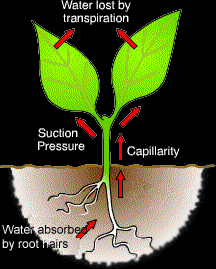 Most plants secure the water and minerals they need from their roots.
Most plants secure the water and minerals they need from their roots.
The path taken is: soil -> roots -> stems -> leaves.
The minerals (e.g., K+, Ca2+) travel dissolved in the water.
Water and minerals enter the root by separate paths which eventually converge in the stele.
Transpiration
Water moves from the soil to the air through a plant down a water potential gradient. The water potential in the soil is generally higher than in the air. The water potential in the leaves is kept lower than the water potential in the soil because of the loss of water vapour by transpiration. Transpiration maintains the water potential gradient.
? Water enters root hair cells by osmosis, moving down a water potential gradient from the water in the spaces between soil particles, through the cell surface membrane and into the cytoplasm and vacuole of the root hair cell.
? The water then moves from the root hair cell to a neighbouring cell by osmosis, down a water potential gradient. This is called the symplast pathway.
? Water also seeps into the cell wall of the root hair cell. This does not involve osmosis, as no partially permeable membrane is crossed. The water then seeps into and along the cell walls of neighbouring cells. This is called the apoplast pathway. In most plant roots, the apoplast pathway carries more water than the symplast pathway.
? When the water nears the centre of the root, it encounters a cylinder of cells called the endodermis. Each cell has a ring of impermeable suberin around it, forming the Casparlan strip. This prevents water continuing to seep through cell walls. It therefore travels through these cells by the symplast pathway.
? The water moves into the xylem vessels from the endodermis.
? Water moves up the xylem vessels by mass flow - that is, in a similar way to water flowing in a river. The water molecules are held together by hydrogen bonds between them, keeping the water column unbroken. There is a relatively low hydrostatic pressure at the top of the column, produced by the loss of water by transpiration. This lowering of hydrostatic pressure causes a pressure gradient from the base to the top of the xylem vessel.
? In a leaf, water moves out of xylem vessels through pits, and then across the leaf by the apoplast and symplast pathways.
? Water evaporates from the wet cell walls into the leaf spaces, and then diffuses out through the stomata.
The diagrams below show the pathway taken by water through a plant.
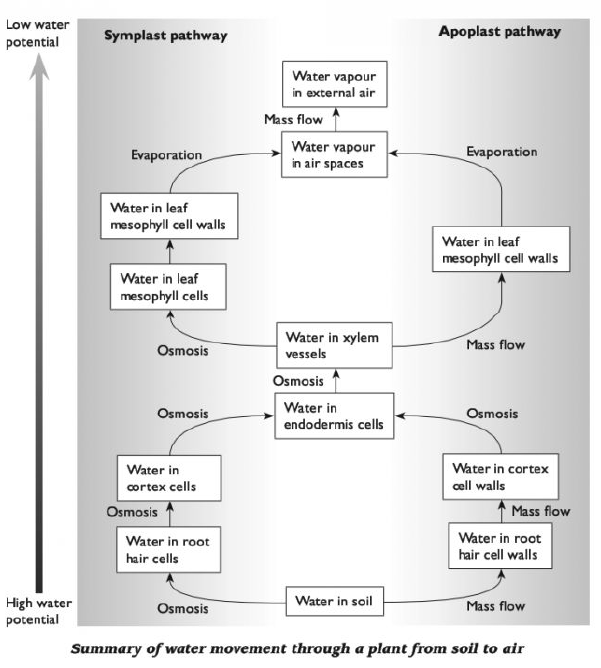
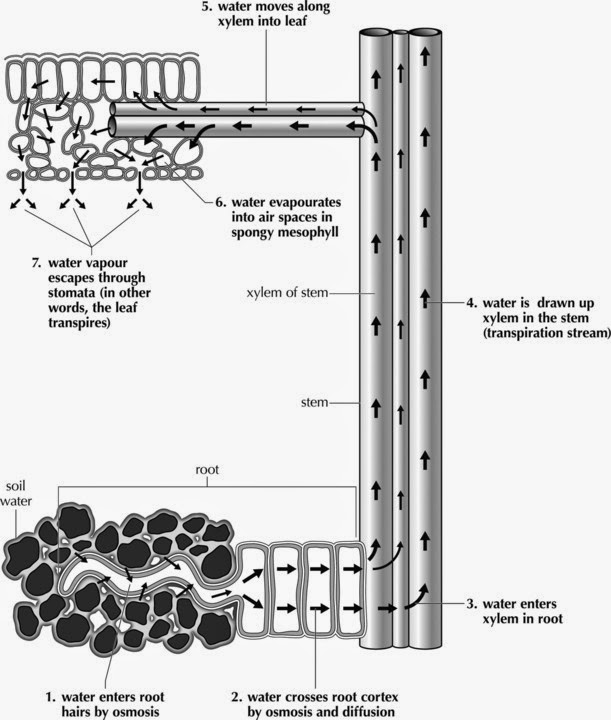
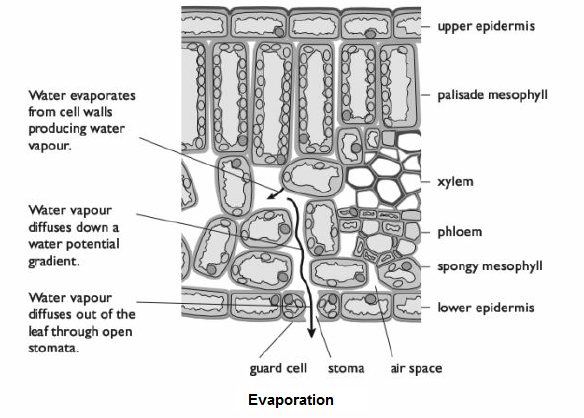
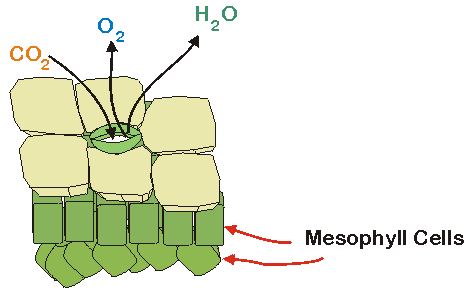
Xerophytes
Plants have evolved over time to adapt to their local environment and reduce transpiration. A xerophyte (desert plant) is a plant that is adapted to live in an environment where water is in short supply.
The adaptations may include:
? leaves with a small surface area to volume ratio. This reduces the amount of surface area from which water vapour can diffuse.
? leaves with a thick, waxy cuticle. This reduces the quantity of water that can diffuse through the surface of the leaf into the air.
? methods of trapping moist air near the stomata, for example rolling leaf with stomata inside, having stomata in pits in the leaf surface, having hairs around the stomata. This produces a layer of high water potential around the stomata, reducing the water potential gradient and therefore reducing the rate of diffusion of water vapour from inside the leaf to outside.
Transpiration is affected by several factors:
- #42 Summary Of Transport In Multicellular Plants
1. Multicellular organisms with small surface area to volume ratios need transport systems. 2. Water and mineral salts are transported through a plant in xylem vessels. Movement of water is a passive process in which the water moves down a water...
- #41 Transport In Phloem
The movement of substances in phloem tissue is called translocation. The main substances that are moved are sucrose and amino acids, which are in solution in water. These substances have been made by the plant and are called assimilates. Phloem...
- #39 Structure Of Transport Tissues In Plants
Plants have 2 transport systems: xylem: transports water and inorganic ions from the roots to the leaves.phloem: transports food made in the plant (sucrose and amino acids) from the leaves to the rest of the plant. Both of...
- #38.2 Transport In Multicellular Plants - Syllabus 2016
7.1 Structure of transport tissues 7.2 Transport mechanisms Flowering plants do not have compact bodies like those of animals. Leaves and extensive root systems spread out to obtain the light energy, water, mineral...
- Comparison Between Active Absorption And Passive Absorption Of Water In Plants
Major differences between Active absorption and Passive absorption of water in plants Active absorption of water Passive absorption of water It occurs due to the activity of root and root hairs. It occurs mainly due to the activity of upper part...
Biology
#40 Movement of Water and Minerals in the Xylem

The path taken is: soil -> roots -> stems -> leaves.
The minerals (e.g., K+, Ca2+) travel dissolved in the water.
Water and minerals enter the root by separate paths which eventually converge in the stele.
Transpiration
- Transpiration is the loss of water from the plant through evaporation at the leaf surface. It is the main driver of water movement in the xylem. Transpiration is caused by the evaporation of water at the leaf, or atmosphere interface; it creates negative pressure (tension) equivalent to ?2 MPa at the leaf surface.
- Water from the roots is pulled up by this tension. At night, when stomata close and transpiration stops, the water is held in the stem and leaf by the cohesion of water molecules to each other as well as the adhesion of water to the cell walls of the xylem vessels and tracheids. This is called the cohesion?tension theory of sap ascent.
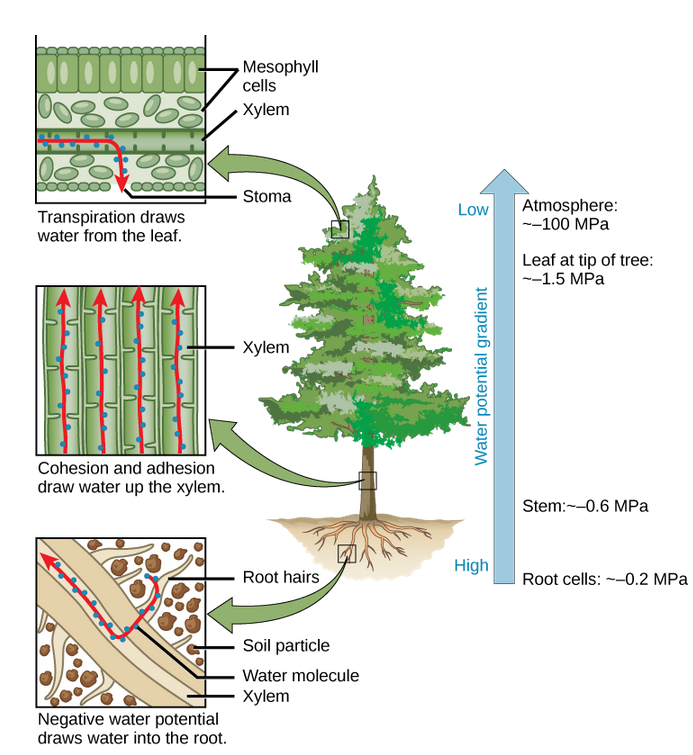 |
Water moves from the soil to the air through a plant down a water potential gradient. The water potential in the soil is generally higher than in the air. The water potential in the leaves is kept lower than the water potential in the soil because of the loss of water vapour by transpiration. Transpiration maintains the water potential gradient.
? Water enters root hair cells by osmosis, moving down a water potential gradient from the water in the spaces between soil particles, through the cell surface membrane and into the cytoplasm and vacuole of the root hair cell.
? The water then moves from the root hair cell to a neighbouring cell by osmosis, down a water potential gradient. This is called the symplast pathway.
? Water also seeps into the cell wall of the root hair cell. This does not involve osmosis, as no partially permeable membrane is crossed. The water then seeps into and along the cell walls of neighbouring cells. This is called the apoplast pathway. In most plant roots, the apoplast pathway carries more water than the symplast pathway.
? When the water nears the centre of the root, it encounters a cylinder of cells called the endodermis. Each cell has a ring of impermeable suberin around it, forming the Casparlan strip. This prevents water continuing to seep through cell walls. It therefore travels through these cells by the symplast pathway.
? The water moves into the xylem vessels from the endodermis.
? Water moves up the xylem vessels by mass flow - that is, in a similar way to water flowing in a river. The water molecules are held together by hydrogen bonds between them, keeping the water column unbroken. There is a relatively low hydrostatic pressure at the top of the column, produced by the loss of water by transpiration. This lowering of hydrostatic pressure causes a pressure gradient from the base to the top of the xylem vessel.
? In a leaf, water moves out of xylem vessels through pits, and then across the leaf by the apoplast and symplast pathways.
? Water evaporates from the wet cell walls into the leaf spaces, and then diffuses out through the stomata.
The diagrams below show the pathway taken by water through a plant.


* Evaporation: A leaf contains many cells in contact with air spaces in the mesophyll layers. Liquid water in the cell walls changes to water vapour, which diffuses into the air spaces. The water vapour then diffuses out of the leaf through the stomata, down a water potential gradient, into the air surrounding the leaf.

Each stoma is surrounded by a pair of guard cells. These can change shape to open or close the stoma. In order to photosynthesise, the stomata must be open so that CO2 can diffuse into the leaf. Plants cannot therefore avoid losing water vapour by transpiration.

Plants have evolved over time to adapt to their local environment and reduce transpiration. A xerophyte (desert plant) is a plant that is adapted to live in an environment where water is in short supply.
| Cacti are xerophytes. |
? leaves with a small surface area to volume ratio. This reduces the amount of surface area from which water vapour can diffuse.
? leaves with a thick, waxy cuticle. This reduces the quantity of water that can diffuse through the surface of the leaf into the air.
? methods of trapping moist air near the stomata, for example rolling leaf with stomata inside, having stomata in pits in the leaf surface, having hairs around the stomata. This produces a layer of high water potential around the stomata, reducing the water potential gradient and therefore reducing the rate of diffusion of water vapour from inside the leaf to outside.
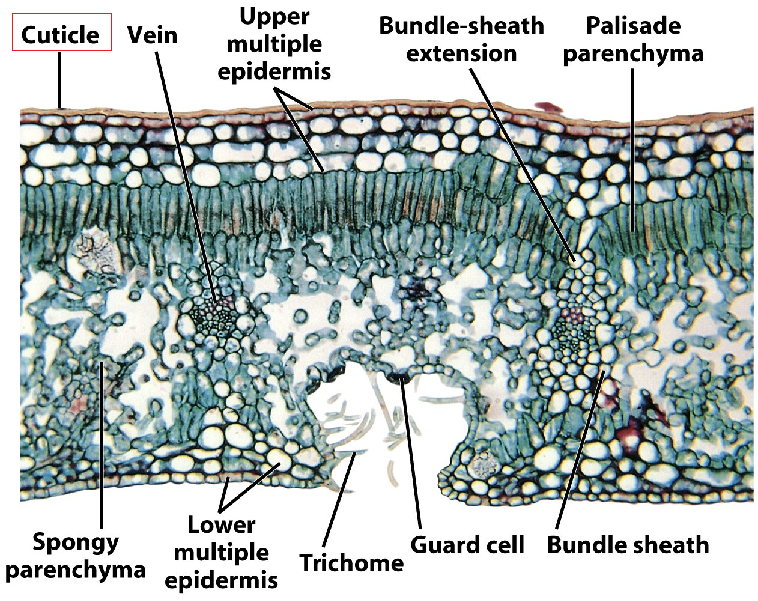 |
| Cross section of a xerophytic leaf. |
- High temperature ?increases the rate of transpiration. This is because at higher temperatures water molecules have more kinetic energy. Evaporation from the cell walls inside the leaf therefore happens more rapidly, and diffusion also happens more rapidly.
- High humidity ?decreases the rate of transpiration. This is because the water potential gradient between the air spaces inside the leaf and the air outside is less steep, so diffusion of water vapour out of the leaf happens more slowly.
- High wind speed ?the rate of transpiration. This is because the moving air carries away water vapour from the surface of the leaf, helping to maintain a water potential gradient between the air spaces inside the leaf and the air outside.
- High light intensity may ? the rate of transpiration. This is because the plant may be photosynthesising rapidly, requiring a rapid supply of CO2. This means that more stomata are likely to be open, through which water vapour can diffuse out of the leaf.
Investigating the factors that affect transpiration rate It is difficult to measure the rate at which water vapour is lost from leaves. It is much easier to measure the rate at which a plant, or part of a plant, takes up water. Most of the water taken up is lost through transpiration, so we can generally assume that an increase in the rate of take-up of water indicates an increase in the rate of transpiration. The apparatus used to measure the rate of take-up of water of a plant shoot is called a potometer. This can simply be a long glass tube. More complex potometers may have reservoirs which make it easier to refill the tube with water, or a scale marked on them. 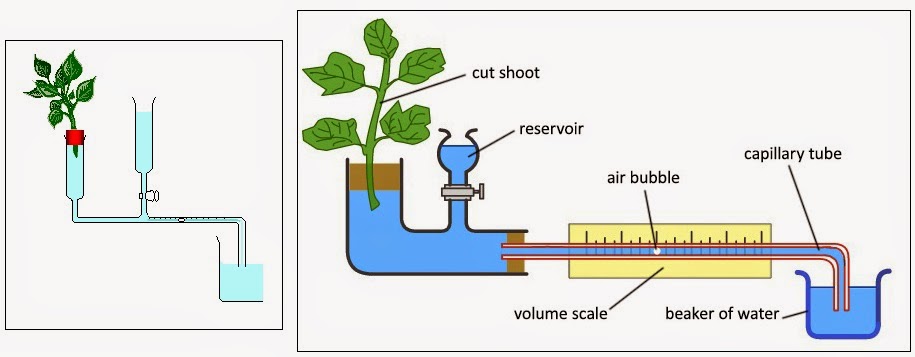 ? Fix a short length of rubber tubing over one end of the long glass tube. Completely submerge the tube in water. Move it around to get rid of all air inside it and fill it with water. Make absolutely sure there are no air bubbles. ? Take a leafy shoot from a plant and submerge it in the water alongside the glass tube. Using a sharp blade, make a slanting cut across the stem. ? Push the cut end of the stem into the rubber tubing. Make sure the fit is tight and that there are no air bubbles. If necessary, use a small piece of wire to fasten the tube tightly around the stem. ? Take the whole apparatus out of the water and support it upright. Wait at least 10 minutes for it to dry out. If the glass tube is not marked with a scaie, place a ruler or graph paper behind it. ? Start a stop clock and read the position of the air/water meniscus (which will be near the base of the tube). Record its position every 2 minutes (or whatever time interval seems sensible). Stop when you have 10 readings, or when the meniscus is one third of the way up the tube. ? Change the environmental conditions and continue to take readings. For example, you could use a fan to increase 'wind speed', or move the apparatus into an area where the temperature is higher or lower. ? Plot distance moved by meniscus against time for each set of readings, on the same axes. Draw best fit lines. Calculate the mean distance moved per minute, or calculate the slope of each line. This can be considered to be the rate of transpiration. |
Syllabus 2015 (b) define the term transpiration (see section 5) and explain that it is an inevitable consequence of gas exchange in plants; (c) [PA] describe how to investigate experimentally the factors that affect transpiration rate; (g) explain the movement of water between plant cells, and between them and their environment, in terms of water potential (no calculations involving water potential will be set); (h) describe the pathways and explain the mechanisms by which water is transported from soil to xylem and from roots to leaves (includes reference to the symplast/symplastic pathway and apoplast/apoplastic pathway); (g) explain the movement of water between plant cells, and between them and their environment, in terms of water potential (no calculations involving water potential will be set); (h) describe the pathways and explain the mechanisms by which water is transported from soil to xylem and from roots to leaves (includes reference to the symplast/symplastic pathway and apoplast/apoplastic pathway); (i) outline the roles of nitrate ions and of magnesium ions in plants; (j) [PA] describe how the leaves of xerophytic plants are adapted to reduce water loss by transpiration; |
Syllabus 2016 7.2 Transport mechanisms Movement of xylem sap and phloem sap is by mass flow. Movement in the xylem is passive as it is driven by evaporation from the leaves; plants use energy to move substances in the phloem. Xylem sap moves in one direction from the roots to the rest of the plant. The phloem sap in a phloem sieve tube moves in one direction from the location where it is made to the location where it is used or stored. At any one time phloem sap can be moving in different directions in different sieve tubes. a) explain the movement of water between plant cells, and between them and their environment, in terms of water potential (see 4.2. No calculations involving water potential will be set) b) explain how hydrogen bonding of water molecules is involved with movement in the xylem by cohesion-tension in transpiration pull and adhesion to cellulose cell walls c) describe the pathways and explain the mechanisms by which water and mineral ions are transported from soil to xylem and from roots to leaves (include reference to the symplastic pathway and apoplastic pathway and Casparian strip) d) define the term transpiration and explain that it is an inevitable consequence of gas exchange in plants e) investigate experimentally and explain the factors that affect transpiration rate using simple potometers, leaf impressions, epidermal peels, and grids for determining surface area f) make annotated drawings, using prepared slides of cross-sections, to show how leaves of xerophytic plants are adapted to reduce water loss by transpiration g) state that assimilates, such as sucrose and amino acids, move between sources (e.g. leaves and storage organs) and sinks (e.g. buds, flowers, fruits, roots and storage organs) in phloem sieve tubes h) explain how sucrose is loaded into phloem sieve tubes by companion cells using proton pumping and the co-transporter mechanism in their cell surface membranes i) explain mass flow in phloem sap down a hydrostatic pressure gradient from source to sink |
- #42 Summary Of Transport In Multicellular Plants
1. Multicellular organisms with small surface area to volume ratios need transport systems. 2. Water and mineral salts are transported through a plant in xylem vessels. Movement of water is a passive process in which the water moves down a water...
- #41 Transport In Phloem
The movement of substances in phloem tissue is called translocation. The main substances that are moved are sucrose and amino acids, which are in solution in water. These substances have been made by the plant and are called assimilates. Phloem...
- #39 Structure Of Transport Tissues In Plants
Plants have 2 transport systems: xylem: transports water and inorganic ions from the roots to the leaves.phloem: transports food made in the plant (sucrose and amino acids) from the leaves to the rest of the plant. Both of...
- #38.2 Transport In Multicellular Plants - Syllabus 2016
7.1 Structure of transport tissues 7.2 Transport mechanisms Flowering plants do not have compact bodies like those of animals. Leaves and extensive root systems spread out to obtain the light energy, water, mineral...
- Comparison Between Active Absorption And Passive Absorption Of Water In Plants
Major differences between Active absorption and Passive absorption of water in plants Active absorption of water Passive absorption of water It occurs due to the activity of root and root hairs. It occurs mainly due to the activity of upper part...
